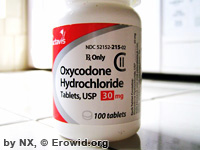Oxycodone (Percocet, Oxycontin)
Basics
DESCRIPTION #
Oxycodone (Percocet, Oxycontin) is a semi-synthetic opioid analgesic (pain killer) similar to morphine. Oxycodone is widely prescribed for the relief of moderate to severe pain, in both regular and time-release forms. It is widely available by prescription and is notoriously addictive, leading many users to have problems controlling their own use.
Oxycodone typically comes in different strengths, including: 5 mg capsules; 5, 10, 15, and 30 mg oral tablets; and 10, 20, 40, and 80 mg sustained-release tablets. Some people choose to grind and insufflate (snort) oxycodone tablets in order to get a stronger effect, however, the use of higher dose sustained-release tablets in this manner can be very dangerous.
An average adult dose is typically 5 mg every six hours. Tolerance develops very quickly; those who take it on a daily basis may find they need to increase their dosage in order to get the same effects. Higher doses, especially the 80 mg sustained-release tablets are for opioid-tolerant people only.
An average adult dose is typically 5 mg every six hours. Tolerance develops very quickly; those who take it on a daily basis may find they need to increase their dosage in order to get the same effects. Higher doses, especially the 80 mg sustained-release tablets are for opioid-tolerant people only.
Price #
Prescription prices vary but have increased since the introduction of the gummy anti-injection/anti-snorting versions of Oxycodone tablets. Prices in the U.S. are in the range of $5-10 per 40 mg tablet in the United States (2013), with street prices around $1 USD per mg ($40 per 40mg tablet). Canadian prices are around 1.25-1.75 CDN per mg for OxyNeo and 2-2.5 CDN per millligram of oxycodone. much lower.
Oxycodone is available by prescription only in most countries. It is Schedule II in the United States, making it illegal to sell without a license and illegal to purchase or possess without a prescription.
Oxycodone is an opioid analgesic, closely related chemically to opioids such as codeine and morphine.
Pharmacology #
As with most other opioids, oxycodone's mechanism of analgesic action is unknown. It is presumed to work by affecting opioid receptors found in the brain.
Production #
Most recreationally consumed oxycodone is diverted from prescription medical uses, rather than produced/manufactured illegally.
History #
Oxycodone was first synthesized in 1916 in Germany and has been used therapeutically since shortly thereafter. It has been available in the United States since about 1939. It became more popular in the 1950s. It was placed into Schedule II in the U.S. in 1970. The sustained-release form (Oxycontin) has been available in the U.S. since 1995/6 and quickly gained popularity.
Terminology / Slang #
Brand Names:
Percocet, Percodan, Endocodone, M-oxy, Oxycontin, Oxydose, OxyFAST, OxyIR, Percolone, Roxicodone, Roxicet, Supeudol, Tylox.
The Substance:
Oxy, Oxies, O.C.'s, Oxycottons, Oxy 80's, Hillbilly Heroin, Roxies, Percs.
The Experience:
Jammed.
EFFECTS #
Primary effects include analgesia (pain relief), sedation, reduction of anxiety, euphoria, and relaxation.
Onset #
Effects are generally felt 10-30 minutes after oral ingestion, although it can take up to an hour to feel the full effects.
Duration #
Oxycodone, when taken orally (and not in sustained-release form) has effects that last last from 3 to 5 hours. Sustained-release tablets last up to 12 hours.
Visual Effects #
Rarely (less than 1% in clinical trials) oxycodone may result in changes in visual perception, or abnormal vision.
PROBLEMS #
Side effects range from the common: constipation, nausea, vomiting, dizziness, headache, itching/pruritus, dry mouth, sweating, fatigue, and weakness; to the less common: impaired thinking, confusion, loss of appetite, nervousness, sleeplessness/insomnia, fever, diarrhea, difficulty urinating, clammy skin, light-headedness, and fainting; to the rare and very concerning: abdominal pain, seizures, convulsions, difficulty breathing, respiratory depression, respiratory arrest, and circulatory depression or shock.
Contraindications #
Combining oxycodone with alcohol or other CNS depressants can lead to a dangerous slowing of the central nervous system and respiratory system. Other contraindications include:
- those hypersensitive to opiates
- history of drug or alcohol abuse
- those with head injuries, increased intracranial pressure, seizures, asthma, COPD, prostatic hyperplassia, severe hepatic or renal disease, acute abdominal conditions, urethral stricture, hypothyroidism, Addison's disease, or arrhythmias
Addiction Potential #
Oxycodone is both physically and psychologically addicting. Anyone taking it, whether for recreational or medicinal reasons, may become addicted, especially if it is used on a daily basis. Tolerance is developed over a period of weeks, resulting in higher doses being needed to achieve the same effects. Withdrawal symptoms, including aches and pains, restlessness, nausea, anxiety, diarrhea, fever, headaches, runny nose, tremors, sweating, vomiting, and trouble sleeping, may be experienced by those ceasing use after regular and especially high-dose use.
Long Term Health Problems #
Long Term Health Problems Summary Needed.
Risk of Death #
Risk of Death Summary Needed.
CAUTION & DISCLAIMER #
Erowid Basics pages are summaries of data gathered from site visitors, government documents, books, websites, and other resources. We do our best to keep this information correct and up-to-date, but the field is complex and constantly changing. Information should always be verified through multiple sources.


